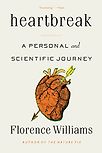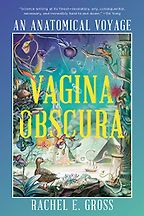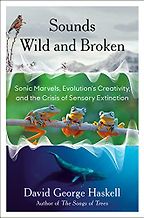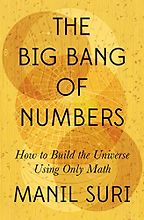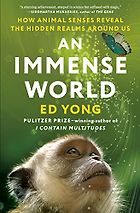What were you looking for when you were judging the books for the 2023 E.O. Wilson Award for literary science writing?
We were looking for good writing, scientific content, and uniqueness. We originally started out with 30 books, which we whittled down to ten, then to these five. Some of the books didn’t make the shortlist because they, perhaps, were too focused on history—this is a science prize, so we needed enough science in there. Some other books really caught our eye thanks to how well-written they were. And some were also just very unique. For example, of the 30 books, only one was on math. We wanted people to see the shortlist and think, hey, maybe I could write something like that. Just carve their own niche.
It might be difficult for you to say, but did you get the sense that it’s been a good year for science writing?
I think so. We had two really excellent books that could easily have been winners, which I think is very good; and all the books were very different. There are often books about animals and nature, but this year there were several new ‘types’ of books in there. There were several books about women’s health, for example, which is great.
Let’s talk about the winning book first. This is Heartbreak: A Personal and Scientific Journey by Florence Williams.
This is an amazing book. It doesn’t feel like a science book when you’re reading it—you don’t get that professorial tone. It’s a very personal book about a woman who is going through a divorce, a topic that we don’t really think science can handle: falling in and out of love. So it’s a completely unexpected book on a topic you wouldn’t think science could touch.
But it is, it’s very scientific. She cites some really amazing studies of hormones, psychological tests, the science of why it hurts so much to be broken up with, and how evolution has made this happen. We’re meant to stay together long enough to make the next generation.
It’s also a hilarious book, there are parts that are laugh-out-loud funny. She has the ability to laugh at herself—a depressed woman going through mourning and recovery.
One of the weaknesses of the science book genre—unlike, say, fiction—is that it doesn’t tend to have a clear plot direction. But this one does. It’s pretty much chronological, and she fits the science in around it. And some of the science stories are really memorable. She talks about ‘the hot sauce test’, which gauges how vindictive people can be to each other. They had participants work together with a partner, a fake partner who is actually a scientist who annoys them by leaving the room for a long time. At some point they have an opportunity to give that partner an amount of hot sauce as punishment. It doesn’t matter how much—it’s not graded or anything—they just have to decide how much to give them to eat. It turns out that men give four times the amount of hot sauce that women do. They’re extremely vindictive, wow.
“Science books are getting much more diverse, which is great, and they are attacking topics we haven’t seen before”
She links it to domestic violence; she says that men basically have trouble limiting the penalty to others when they are hurt emotionally. So it’s a hilarious experiment, but it also has some deeper meaning. I think when you can laugh, but can better see where she’s coming from. So, for me, I was really happy that this book won.
It’s a shorter book. Some science books can really go on and on, but Florence Williams doesn’t, plus she’s a hilarious and very, very engaging writer. And the topic, the psychology of love, could help bring the science genre to a broader audience. Not everyone wants to read about physics or math, but pretty much everyone has experienced being dumped.
We also thought it was a good book for our era. The Covid generation has seen many deaths in the past few years, and many of us have spent a lot of time alone. This book talks about loneliness and the hormones linked to that. That was important for us too. I’m really happy that this is our winner.
Great. Thanks for that. Perhaps next you could talk me through Rachel E. Gross’s Vagina Obscura. What did you admire about it?
This book is about female anatomy, and also the unsung heroes who have worked in these topics: the hidden figures of female health. For example, there was a laboratory technician Miriam Menkin who discovered how to do IVF.
We thought this was an important book. It showed how sexist a lot of the discussion of reproduction has always been.
Really? How so?
Well, if you were educated the way I was, you learn that sperm are on this voyage to meet the egg. It’s like a Western cowboy. There’s a damsel in distress and it goes to find her. This book turns that on its head. It says, actually, the vagina came first. Males are just trying to keep up. It’s like: which came first, the chicken or the egg? The penis or the vagina? Well, the vagina definitely came first. The most important thing for mammals is that they have to give birth, so foremost, the vagina has to accommodate this cantaloupe-sized head coming out of it while also obtaining sperm. That has driven all sorts of different male ways to deal with the vagina.
Get the weekly Five Books newsletter
As a result, the penis can have all these different shapes. It has to fit the vagina. She talks about duck vaginas, which are spiral-shaped, and duck penises, which are spiral-shaped in reverse.
There’s also this thing called ‘cryptic female choice’: all the ways female animals have developed to decide who the father of their children are going to be. Some can make chemicals that lead particular sperm to the egg, some can just get rid of the sperm and the egg—spontaneous abortion—and all these other ways to decide who is going to be the father. It’s called cryptic because the male doesn’t know, nobody knows what’s happening on the inside. All of these are evolutionary traits that basically trick the penis. These evolved to give the female animal more ability to evade poor mates and choose the best ones.
She also talks about amazing reconstructive surgeries; women who have had their clitoris removed as part of genital mutilation can undergo surgeries to reconstruct it. Luckily around 90% of the nerves are still under the surface, so they bring those back up. And she talks about gender affirming surgeries, in which they invert penises and turn them into vaginas—surgeons can take out the testicles and use the skin to make the labia.
Oh, and—ovaries are also there for generating hormones like oestrogen. Oestrogen is not just something that women need, men need it too; if you don’t have oestrogen, you never stop growing.
It sounds full of fascinating facts.
We also thought it was special because it tackled a topic that people hadn’t written that much on before. And it was pretty funny as well. It felt like a book that needed to be published, and it was chock full of information.
Next on the shortlist we have previous Five Books interviewee David George Haskell’s Sounds Wild and Broken, a study of our aural landscapes. Can you tell us more?
Yes. Sound is a way that many animals communicate with each other and much of the information it is stuff that we can’t hear. For example, he talks about these insects, treehoppers, who communicate in ultrasound and you can only hear them with special microphones—but when you do, they are incredibly loud.
He also talks about how the ocean is connected over very long distances by invisible conduits he calls “deep sound channels.” People thing the ocean is uniform, but it has zones called channels, whose edges are created by differences in salinity. Whales deep underwater can communicate over hundreds of miles by singing in these channels. Sound bounces off the edges and travels continuously, in one direction, basically sending sound that you can hear around the world. Whales are constantly communicating through these things.
One part that really stuck with me was how sound and human health are related. If you hear sounds above a certain level, your heartbeat will go up and your stress levels will go up. Some of this is unconscious. So it made me think about the sound levels around me, and how a lot of underrepresented communities often have highways built right next to them.
He gives the example of Harlem in New York, which has a highway going right through it. Often these places use old, loud, diesel buses rather than the electric buses, too. So the sound levels are higher, pollution is higher, it’s a lot harder for people to focus. The use of sound to oppress under-represented groups was sobering and eye-opening.
There are times when Haskell’s writing becomes almost poetic. I thought that was great, it’s very different from a typical science book.
Right, because this is specifically a literary science writing prize. So that moves the emphasis away from popular science, or other more straight-forwardly written books.
Yes, there are other science awards that only emphasize the science. And we could tell that Haskell and some of the others really paid attention to the literary aspect.
I think Ed Yong’s book An Immense World would be the next natural step. I know these two books have some things in common.
Yes. An Immense World is an immense book that really tackles big ideas. It starts off with this idea of the umwelt, basically our sensory bubble. For example, human vision only covers light between one frequency and another. We can’t see ultraviolet, we can’t see infrared, but a lot of other animals can. Some animals will have a bigger umwelt, and still others will have smaller umwelt focused only on what they need to know.
Like those treehoppers: all they hear is other treehoppers. They only listen to that specific frequency. And some moths can only smell female moths, and nothing else. That’s all they need. It’s a bit like how some insects can’t eat in their adult form. They only need to live long enough to find their mate, so that’s what they do with laser focus.
There are other senses too that we don’t have. Like some animals are able to sense electromagnetic fields. That’s how they can migrate long distances. It’s why hammerhead sharks have that hammerhead, it’s a bit like a metal detector.
Right, they recognise the electric signature of other beings.
They think, ‘oh, there’s a flounder’, and they eat the flounder. It makes you appreciate that we are very limited. We sometimes see animals as being lower down on the evolutionary tree, but the reality is that animals have evolved to the exact state that they need. That might be being able to see and hear only a very small number of things is enough so that they can propagate their species.
The reason that we thought this book was special was that some of these concepts would be really tough to understand without the book. For example, electromagnetic waves, or how sound is propagated; he gets you to learn some basic physics of how these things work. I think that’s important. It’s a challenging topic, because the physics can be sort of abstract, but he brings in examples of animals that can do all these tasks.
It’s also funny and personal—there’s a hilarious bit about manatees doing “oripulation” using their face and whiskers to explore his hand intimately, and he felt like he was being harassed. Another positive feature is that much of the science covered is very recent. I’m a professional scientist but a good portion of this book was about topics I didn’t know about because they are being researched right now. The book is a huge accomplishment but he’s also very humble about his role in it.
Great. Let’s turn our attention to the final book on the shortlist: Manil Suri’s Big Bang of Numbers.
Well, when I go around giving talks, people will say to me: I’m a math person, but there’s no book I can give to my parents. Some of the math books out there are difficult to read, but this isn’t one of them. It’s not trying to boggle your mind. It’s an elegant journey explaining why we have the number and math systems that we have.
He walks you through the beginning of the invention of numbers. Everyone knows one, two, three, four. All cultures have this. But once you have these numbers, you can invent operations like addition and subtraction. Once these operations exist, you must create the concept of zero. It took some time to come up with the idea of zero because it’s very abstract, you can’t see it. You can only imagine zero. But once you have zero, it leads elsewhere.
There’s this question: is math invented or discovered? I think from this book, you get that it is discovered. It’s natural that we are going to come up with this system; it’s like carbon or oxygen, waiting to be discovered, one of the periodic table of elements. For example, if you have zero, you then have negative numbers. Once you invent multiplication, division follows, and you naturally have fractions.
Fractions are useful, and they can be ordered by size. Then he shows how these concepts lead to the idea of rational numbers, which are decimals that can be written in terms of fractions. These lead to the idea of irrational numbers like Pi that starts 3.141… and goes on forever without any numerical patterns. He says that the fact pi goes on forever is an important concept because it fits in between the fractions. If it were finite, you could write it as a fraction. But there’s an infinite number of these irrational numbers out there. He goes on to show how the idea of fractals came about. Next is the concept of algebra: how do you solve for unknowns?
You don’t actually do any math in the book, he talks about what, chronologically, was next discovered, and the next step that makes sense. It took hundreds of years to make each discovery, but each step is logical. He’s basically explaining the mathematical ideas you use every day. It’s elegant, it’s beautiful, and the level is quite reasonable.
The pleasure of good science writing is that people who are not specialists can get at least a glimpse of the satisfaction of understanding these big ideas.
Yes, and I think people appreciate it and take something away. Suri is a professor, and as someone from that community, I know have confused people and made people fall asleep. So how do you get people to understand, and make it engaging, and make it long enough to be a whole book? That’s the task.
Is there anything you want to add?
I think that science books have changed quite a bit. They are getting much more diverse, which is great, and they are attacking topics we haven’t seen before. For example, before Heartbreak, Florence Williams wrote a book about breasts that won a prize. Today, we’re getting different kinds of authors who are writing new kinds of books. The writing is also getting more personal than before. People are less afraid to talk about their vulnerabilities and their weaknesses, and that makes it more human. Tone-wise, they are less worried about sounding authoritative, and I think that’s great. There’s more humour, some of these books are downright funny. So I’m glad science books are going in this direction, and that they truly integrate the science. If you took the science out of them, they wouldn’t be so good.
Interview by Cal Flyn, Deputy Editor
March 21, 2023
Five Books aims to keep its book recommendations and interviews up to date. If you are the interviewee and would like to update your choice of books (or even just what you say about them) please email us at [email protected]
Five Books interviews are expensive to produce. If you've enjoyed this interview, please support us by donating a small amount.

